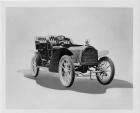|
Re: Potential 327 overbore questions
|
||||
|---|---|---|---|---|
|
Home away from home

|
While yes, a larger displacement will get you more power, most of the improvement you will get will come from an improved ring seal.
The '54 Super Clipper 327 put out 165hp, or 2ci per horsepower. Adding 11ci should get you 6hp, all other things being equal.
Posted on: 2013/5/9 8:28
|
|||
|
1954 Clipper Super Touring Sedan -5462
|
||||
|
||||
|
Re: Potential 327 overbore questions
|
||||
|---|---|---|---|---|
|
Home away from home

|
You could possibly gain more power via a slight increase in compression ratio, as the standard ratio is very low (at around low 7's from memory) and suited for use with the types of fuel available back then. Higher compression perhaps could be achieved by taking a little off the cylinder head and running higher octane fuel. It's a fairly small ROI either way, given the great torque and tractability of the 327's.
I'm not aware of how much can be 'safely' taken off the cylinder head of a 327 . . . See what others with more knowledge of these engines say about that.
Posted on: 2013/5/9 9:13
|
|||
|
1951 Packard Club Sedan | [url=ht
|
||||
|
||||
|
Re: Potential 327 overbore questions
|
||||
|---|---|---|---|---|
|
Forum Ambassador

|
How much you can shave off before you run into valve clearance problems depends on how much (if any) has been already milled or ground off in the past. There is no recovery other than a new head once you've gone too far, so if you can't determine the past history, I'd leave it alone. Or if you're determined, you can measure the highest point of the valve rise from the block surface and compare to the area above the valve in the combustion chamber. The thickness of the compressed head gasket should provide a reasonable margin.
Posted on: 2013/5/9 9:27
|
|||
|
||||
|
Re: Potential 327 overbore questions
|
||||
|---|---|---|---|---|
|
Home away from home

|
The factory suggestion was to run a 288 head on the 327 engine to increase compression ratio, wasn't it? Didn't it garner a half a point increase on compression ratio?
Good luck! Mark
Posted on: 2013/5/11 0:15
|
|||
|
||||
|
Re: Potential 327 overbore questions
|
||||
|---|---|---|---|---|
|
Home away from home

|
Hi
Thanks for all your responses, though the motivation was to determine if Packard could have simplified their engine building for 1954. Simply bored all their blocks to 3 9/16, let the stroke determine the cubic inch differential. As greater horsepower and torque were all the rage, having 339 and 359 engines to advertise could have been a help to sales appeal. Clearly by the trouncing Packard took that year, they needed all the helpful features they could get to compete. Steve
Posted on: 2013/5/12 17:19
|
|||
|
||||








